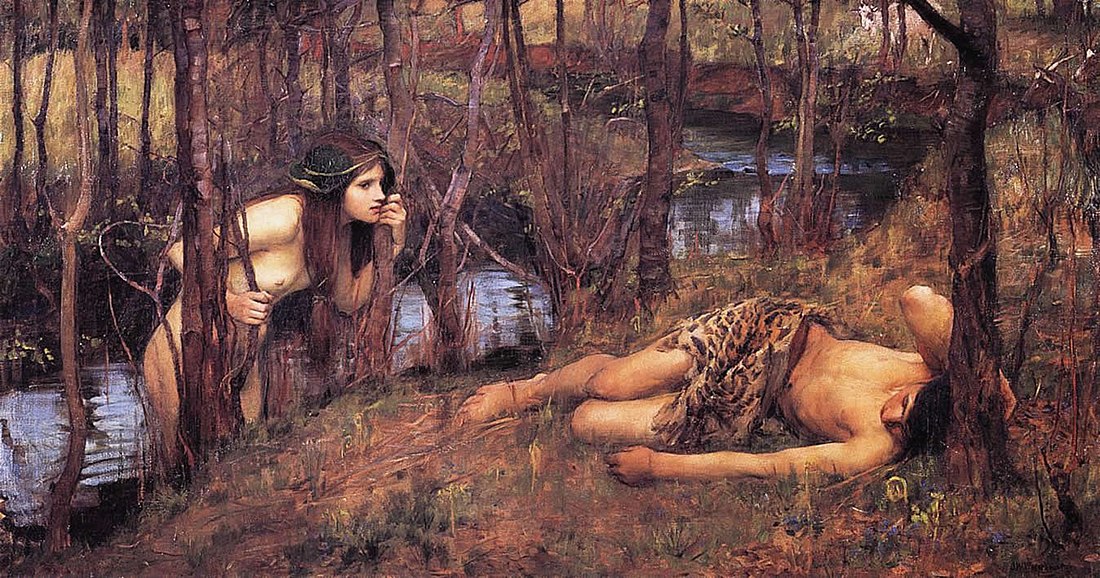Top Qs
Timeline
Chat
Perspective
Naiad
Female spirit or nymph in Greek mythology From Wikipedia, the free encyclopedia
Remove ads
In Greek mythology, the naiads (/ˈnaɪædz, ˈneɪædz, -ədz/; Ancient Greek: ναϊάδες, romanized: naïádes), sometimes also hydriads,[1] are a type of female spirit, or nymph, presiding over fountains, wells, springs, streams, brooks and other bodies of fresh water.
This article needs additional citations for verification. (December 2021) |
They are distinct from river gods, who embodied rivers, and the very ancient spirits that inhabited the still waters of marshes, ponds and lagoon-lakes such as pre-Mycenaean Lerna in the Argolis.
Remove ads
Etymology
The Greek word is ναϊάς (naïás [naːiás]), plural ναϊάδες (naïádes [naːiádes]). It derives from νάειν (náein), "to flow", or νᾶμα (nâma), "body of flowing water".[citation needed]
Mythology
Summarize
Perspective

Naiads were often the object of archaic local cults, worshipped as essential to humans. Boys and girls at coming-of-age ceremonies dedicated their childish locks to the local naiad of the spring. In places like Lerna their waters' ritual cleansings were credited with magical medical properties. Animals were ritually drowned there. Oracles might be situated by ancient springs.
Naiads could be dangerous: Hylas of the Argo’s crew was lost when he was taken by naiads fascinated by his beauty. The naiads were also believed to exhibit jealous tendencies. Theocritus's story of naiad jealousy was that of a shepherd, Daphnis, who was the lover of Nomia or Echenais; Daphnis had on several occasions been unfaithful to Nomia and as revenge she permanently blinded him. The nymph Salmacis raped Hermaphroditus and fused with him when he tried to escape.
The water nymph associated with particular springs was known all through Europe in places with no direct connection with Greece, surviving in the Celtic wells of northwest Europe that have been rededicated to Saints, and in the medieval Melusine.
Walter Burkert points out, "When in the Iliad [xx.4–9] Zeus calls the gods into assembly on Mount Olympus, it is not only the well-known Olympians who come along, but also all the nymphs and all the rivers; Okeanos alone remains at his station",[2] Greek hearers recognized this impossibility as the poet's hyperbole, which proclaimed the universal power of Zeus over the ancient natural world: "the worship of these deities," Burkert confirms, "is limited only by the fact that they are inseparably identified with a specific locality."[2]
Remove ads
Interpretation
In the back-story of the myth of Aristaeus, Hypseus, a king of the Lapiths, married Chlidanope, a naiad, who bore him Cyrene. Aristaeus had more than ordinary mortal experience with the naiads: when his bees died in Thessaly, he went to consult them. His aunt Arethusa invited him below the water's surface, where he was washed with water from a perpetual spring and given advice.
Place names
- St. Charles Avenue in New Orleans was formerly known as Nyades Street, and is parallel to Dryades Street.[citation needed]
- Naiad Lake in Antarctica is named after the nymphs.[3]
- Naiad, the innermost moon of Neptune, is named after the nymphs.
Gallery
- Naiads, Cyprian Kamil Norwid, 1846
- Gioacchino Pagliei - The Naiads, 1881
- Fountain of the Naiads, 1888, Piazza della Repubblica, Rome
- Hylas and the Water Nymphs by Henrietta Rae, 1909
- The Invocation of the Water Nymphs by Marek Hapon, 2013
See also
Notes
References
Wikiwand - on
Seamless Wikipedia browsing. On steroids.
Remove ads






